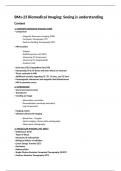Summary
Summary - Biomedical Imaging (BMs23)
- Course
- Institution
An in depth summary of the "Biomedical Imaging (BMs23 course)". This summary contains all material discussed in the course and you should easily pass the exam using this. In addition, this summary can be used outside this course for a clear and complete description of MRI, ultrasound, PET, SPECT, X...
[Show more]



